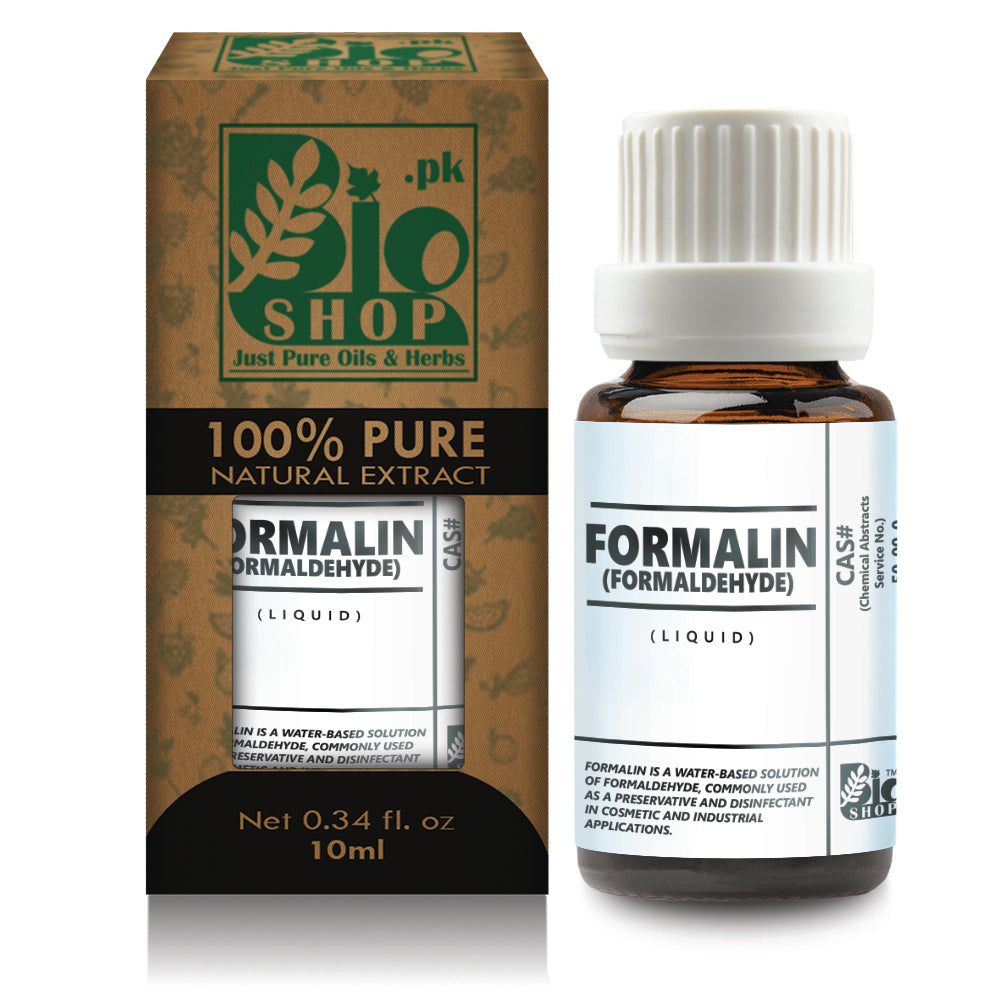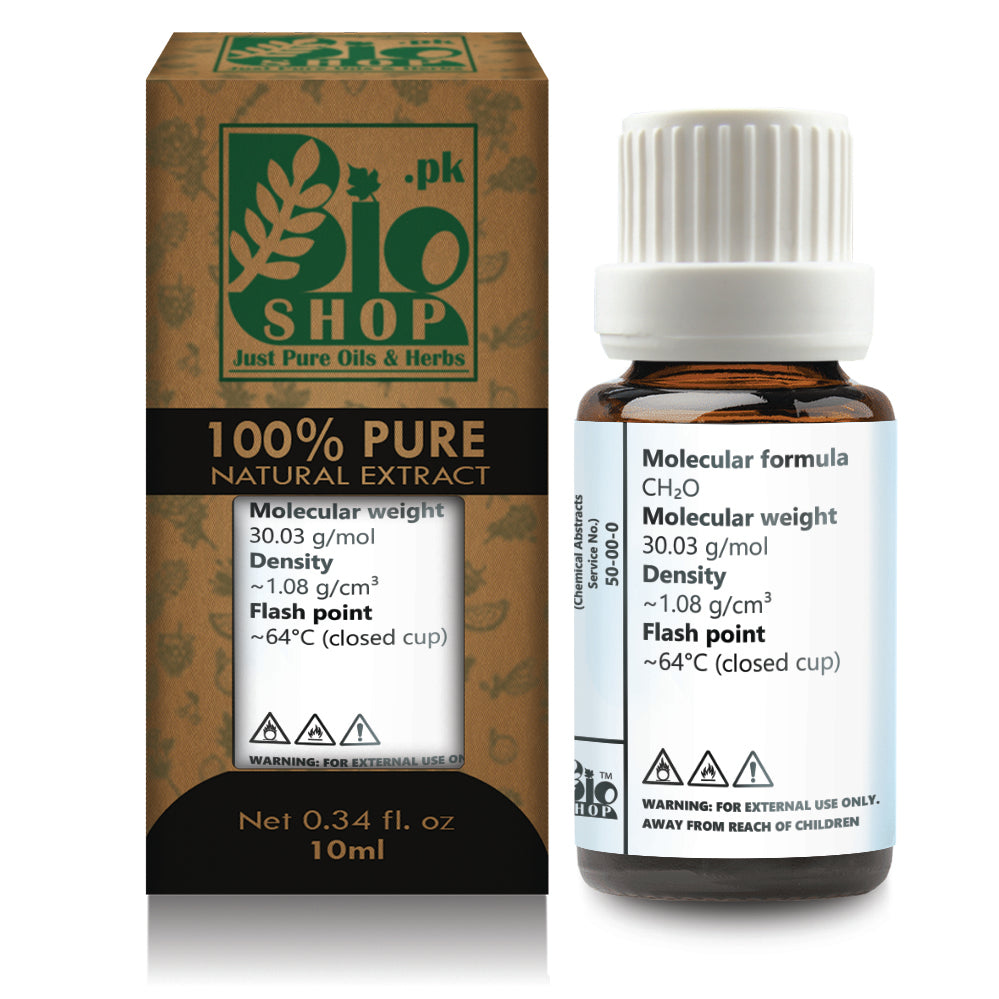Bio Shop
Formalin (Formaldehyde)
Formalin (Formaldehyde)
Key Functions: Serves as a potent antimicrobial, disinfectant, and preservative in controlled cosmetic and industrial formulations.
Couldn't load pickup availability


Explore
Information About Formalin (Formaldehyde)
✅ Key Features
- Highly effective preservative against bacteria, fungi, and mold
- Used in controlled concentrations in hair smoothing treatments and disinfectants
- Also acts as a fixative in lab and industrial applications
- Requires careful usage with regulated limits
- Clear, aqueous solution containing formaldehyde gas
🔬 Description
Formalin (Formaldehyde) – Powerful Antimicrobial Preservative for Industrial & Cosmetic Use
Formalin is a clear, aqueous solution of formaldehyde gas (typically 37%) stabilized with methanol. In cosmetic and industrial applications, it is recognized for its strong antimicrobial and preservative properties. It has been used in hair straightening treatments, antifungal agents, and disinfectants. Due to its potent nature and regulatory restrictions, it must be used at very low concentrations and with appropriate warnings in end products. Often used in industrial settings, lab preservation, and hair-smoothing systems, it should be handled with care and in compliance with safety standards.
📊 Technical Data
INCI Name: Formaldehyde
CAS Number: 50-00-0
Solubility: Water-soluble
Add Phase: Cool-down or final phase with strict control
pH Stability: Best used at neutral to acidic pH (4.5 – 6.5)
Processing Temperature: Below 45°C
Appearance: Clear, colorless liquid
Odor: Pungent, sharp smell
Molecular Formula: CH2O
Molecular Weight: 30.03 g/mol
Flash Point: ~64°C
Density: ~1.08 g/cm³
Chemical Type: Aldehyde (organic compound)
Functional Groups: Carbonyl
Primary Cosmetic Uses: Preservative, antifungal, hair straightening agent (restricted use)
🧪 Recommended Usage
- Usage Rate: 0.1% – 0.2% (maximum in cosmetics where allowed)
- Phase: Final or cool-down phase
- Ideal For: Hair Smoothing Systems, Industrial Preservatives, Nail Hardeners
💡 Pro Tip
⚠️ Always wear gloves, mask, and work in a well-ventilated area when using formalin. For cosmetic use (where legal), ensure the concentration is well below 0.2% and the product is rinse-off. Include a clear label stating the presence of formaldehyde.
👩🔬 Skin Type Compatibility
⚠️ Not recommended for leave-on skin care products
❌ Avoid use on sensitive skin or mucosal areas
✔️ Industrial and rinse-off use only, with proper neutralization and safety labeling
🧴 Formulation Ideas
1. Hair Straightening Solution (Professional Use Only)
Used in regulated quantities to alter disulfide bonds in hair for semi-permanent smoothing. Always follow safety protocols and ventilation guidelines.
2. Industrial Disinfectant Spray
Diluted with water and ethanol for surfaces in labs, clinics, and manufacturing zones.
3. Nail Hardener
Combined in small amounts (0.1–0.2%) to strengthen nail keratin in commercial polish or hardeners.
4. Specimen Preservation Fluid
Used for biological tissue fixation in scientific and academic environments.
5. Antifungal Cleaning Solution
Formulated with formalin and stabilizers to prevent mold/mildew on surfaces in industrial environments.
💧 Cosmetic Suitability:
Serums
☆☆☆☆☆ – Not Suitable
🟥⬜⬜⬜⬜ – Unsafe for leave-on face applications.
Creams & Lotions
☆☆☆☆☆ – Not Suitable
🟥⬜⬜⬜⬜ – Not advised due to irritation potential.
Toners
☆☆☆☆☆ – Not Suitable
🟥⬜⬜⬜⬜ – High reactivity; not skin-safe in tonics.
Face Masks
⭐☆☆☆☆ – Poor
🟥⬜⬜⬜⬜ – Not advised for topical use.
Cleansers
⭐⭐☆☆☆ – Fair
🟧🟧⬜⬜⬜ – Only in rinse-off industrial hand washes.
Hair Masks
⭐⭐⭐⭐☆ – Good
🟩🟩🟩🟩⬜ – Used in professional keratin/straightening systems.
Deodorants
☆☆☆☆☆ – Not Suitable
🟥⬜⬜⬜⬜ – Not safe for underarm use.
Eye Creams
☆☆☆☆☆ – Not Suitable
🟥⬜⬜⬜⬜ – Avoid due to irritation risk.
Shampoos
⭐⭐⭐☆☆ – Moderate
🟧🟧🟧⬜⬜ – Rinse-off use only with neutralization.
Soaps
⭐⭐☆☆☆ – Fair
🟧🟧⬜⬜⬜ – Preservative only; avoid prolonged contact.
Conditioners
⭐⭐⭐⭐☆ – Good
🟩🟩🟩🟩⬜ – Used in smoothing systems; not daily-use.
Lip Balms
☆☆☆☆☆ – Not Suitable
🟥⬜⬜⬜⬜ – Do not use on lips or mucous membranes.
Body Butters
☆☆☆☆☆ – Not Suitable
🟥⬜⬜⬜⬜ – Unsuitable for direct skin application.
Ointments
☆☆☆☆☆ – Not Suitable
🟥⬜⬜⬜⬜ – Not recommended due to high reactivity.
❓ FAQs
Q1: Is formalin banned in cosmetics?
A1: In many regions, formaldehyde is restricted or banned in leave-on cosmetics. It may be allowed in small concentrations in professional or rinse-off use.
Q2: Can I use this in hair straightening treatments?
A2: Yes, but only in regulated concentrations under professional use conditions.
Q3: Is this the same as methylene glycol?
A3: Formalin contains formaldehyde gas dissolved in water (with some methanol), often interchanged with methylene glycol in solution.
Q4: Does formalin preserve oils?
A4: No — it’s a microbial preservative, not an antioxidant. Use BHT for oil-phase stabilization.
Q5: Is formalin carcinogenic?
A5: Prolonged exposure to high levels is linked to health risks. Always follow regional safety and legal guidelines.
📂 Documentation
Upon request, we will provide.
Where Can You Safely Use Formalin (Formaldehyde)
Discover how Formalin (Formaldehyde) performs across different products — rated for safety, stability, and effectiveness.



